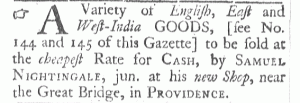GUEST CURATOR: Ceara Morse
What was advertised in a colonial newspaper 250 years ago this week?

“A Variety of English, East and West-India GOODS, … to be sold at the cheapest Rate for CASH.”
In this advertisement in the Providence Gazette, Samuel Nightingale, Jr., sold an assortment of goods from England, as well as both the East and West Indies, in his “new Shop, near the Great Bridge” in Providence.
Since this advertisement mentions earlier issues that included the actual information about what was being sold, I went in search of them. In issue 145, published on October 25, 1766, I found a much larger advertisement with a vast list of goods. The majority of the items on the list were linens and other sorts of textiles, but it also included other things, such as “Ivory and buckling combs,” “Pewter dishes, plates and basons,” and “Flat irons. English Steel.”

Pewter was very popular in the eighteenth century. James A. Mulholland notes that “[a]ll but the poorest families owned at least one or two pewter items, and wealthier families accumulated substantial inventories of pewterware, including porrigngers, tankards, coffeepots, and candlesticks.”[1] He also noted that the majority of pewter came from England.
**********
ADDITIONAL COMMENTARY: Carl Robert Keyes
I was very excited when Ceara selected this advertisement. When guest curators are participating in this project I leave the decisions about which advertisements to feature to them, provided they follow the project’s methodology. That means that they sometimes pass over advertisements that I find either interesting or significant, but that’s just the way it goes sometimes when working on a collaborative project. After all, the guest curators can learn something interesting or significant about colonial America from any advertisement.
Why was I so excited when Ceara submitted this advertisement for approval? She mentioned the reason in her own analysis. Samuel Nightingale, Jr., instructed potential customers to “[see No. 144 and 145 of this Gazette]” for a list of the “Variety of English, East and West-India GOODS” that he sold. When she noticed this, Ceara did the sort of historical detective work that I consider an enjoyable part of this project: she consulted the earlier issues (October 11 and 18, 1766) of the Providence Gazette to find out more about those advertisements. In the process, she discovered an advertisement that resembled others by Thompson and Arnold and Benjamin Thurber and Edward Thurber, both previously featured by the Adverts 250 Project.
In the course of a few weeks, Nightingale published two advertisements with rather extraordinary features. His first advertisement borrowed innovations from competitors, but those innovations had not been so widely adopted that Nightingale’s advertisement blended in with others. With a decorative border and spanning two columns, Nightingale’s earlier advertisements dominated the pages on which they appeared.

Today’s advertisement did not have the same visual impact, but it did incorporate one rather unusual feature. It instructed readers to consult another newspaper to see the original advertisement. Nightingale assumed a high level of interest among potential customers. At the very least, he hoped to incite interest by offering a brief description and then challenging readers to find the original advertisements in earlier issues.
This tells us something about how colonists used newspapers. Nightingale’s directions to “[see No. 144 and 145 of this Gazette]” only worked if readers still had access to those issues. It suggests that subscribers held on to newspapers for at least several weeks to consult the news, advertisements, and other items they contained. Newspapers were not immediately ephemeral in the eighteenth century. In turn, that means that the advertisement printed in colonial newspapers had longer lives than the week that passed before the publication of the next issue.
Running his lengthy advertisement for two weeks may have been a significant investment for Samuel Nightingale, Jr., but it may also have been a risk worth taking if he could depend on it to keep circulating for quite some time after that. To shore up his bet, today’s brief notice directed potential customers back to the impressive original advertisement.
**********
[1] James A. Mulholland, History of Metals in Colonial America (Tuscaloosa: University of Alabama Press, 1981), 95.
